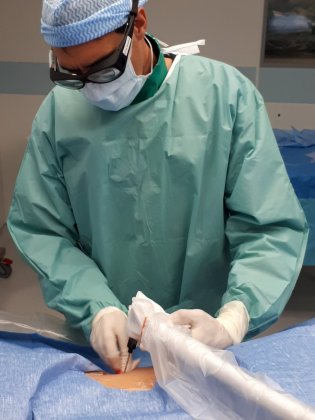
Breast Cryotherapy
What is percutaneous cryotherapy?
Breast tumors, both cancerous and benign, occur frequently in women. A multidisciplinary team meeting (MDTM) is systematically held to determine the therapeutic strategy that will be proposed to each patient. In some cases, the appropriate treatment might be cryotherapy.
Cryotherapy consists in inserting a thin needle, or probe, into the tumor. Extreme cold at the tip of the probe causes an ice ball to form around the tumor, thus eliminating the cancer. The procedure takes less than one hour, is minimally invasive (leaving only a tiny scar measurable in millimeters), and can be performed under local anesthesia, which allows the patient to leave the hospital immediately after the procedure.
What happens during a breast cryotherapy procedure?
Breast cryotherapy is a non-invasive procedure that uses an innovative percutaneous approach —meaning the treatment is delivered directly through a needle—with no incision other than the needle stick.
Like a breast biopsy, the procedure begins with the administration of a local anesthesia. Then, guided by various imaging techniques (mammography, ultrasound or CT scan), the radiologist determines the exact location of the tumor, and precisely positions the cryotherapy probe at its center.
Liquid nitrogen circulating inside the probe causes an ice ball to form around its tip. The extreme cold generated by the ice destroys the tumor. While the ice ball forms, the radiologist ensures that it completely covers the tumor without invading the adjacent tissues. When the ice ball becomes large enough to destroy the whole tumor, the probe is thawed and can then be removed.
Is breast cryotherapy painful?
Local anesthesia is administered at the beginning of the procedure, before the needle is inserted.
The freezing phase is not painful because the cold also has an anesthetizing effect. The procedure leaves a tiny incision that closes within a few hours.
Our team is especially attentive to the patient’s comfort during the procedure. Music therapy is proposed to help patients more fully relax, and a nurse stays with the patient for the duration of the procedure.
The post-operative phase is typically very simple and painless, and patients can resume their everyday activities as soon as they return home.
What are the outcomes and benefits?
This treatment results in the complete destruction of the tumor almost 100 percent of the time, as long as all the criteria for cryotherapy have been met. That is why each patient’s case must be discussed beforehand during a multidisciplinary team meeting. According to the largest study published to date on the treatment of small, low grade tumors with a good prognosis, more than 99 percent of the tumors showed no sign of recurrence after an average of 35 months of follow-up monitoring.
Cryotherapy’s main advantage is that it is minimally invasive. Similar to a breast biopsy, it is performed on an outpatient basis, with no need for hospitalization. When cryotherapy is performed under the proper conditions, the post-operative phase is very simple and patients can resume their normal activities on the same day.
What to expect during a cryotherapy procedure at the American Hospital of Paris
Once an exact diagnosis has been made of the disease and its potential spread, the decision to perform cryotherapy must be discussed and approved during a multidisciplinary team meeting.
Before the procedure, the patient must see the interventional radiologist for an in-person or remote consultation.
On the day of the procedure, the patient is accompanied to the radiology room where the radiologist is expecting her. The procedure generally lasts 30 minutes. A nurse stays with the patient and provides support for the duration of the procedure.
Once the sterile field is in place, the radiologist administers the local anesthesia, which takes effect almost immediately. He or she then inserts the cryotherapy probe into the tumor and releases the nitrogen, causing an ice ball to form. Throughout the freezing phase, the radiologist adjusts the parameters of the probe to ensure the ice ball reaches an optimal size. Two successive freezing cycles are generally applied, for a total of ten to twenty minutes.
After the freezing phase, the probe is warmed up and removed. A bandage is placed over the puncture site, and the procedure is over.
The patient can return home after the procedure, with no need for in-hospital monitoring. Should any problems arise, an interventional radiologist can be reached 24 hours a day, seven days a week.
All information regarding the cryotherapy procedure is systematically included in the patient’s medical file, and our radiologists are in regular contact with the oncologists, surgeons and radiation therapists to ensure each patient receives optimal care.

Quels sont les effets secondaires de ce traitement ?
La cryothérapie du cancer du sein est une technique mini-invasive de radiologie interventionnelle, réalisée en ambulatoire sous anesthésie locale. Les effets secondaires sont extrêmement faibles et le taux de complications majeures est inférieur à 1%. Seuls quelques cas d’infection post-opératoire ou de formation d’hématome ont été rapportés (mais dans des proportions inférieures à l’intervention chirurgicale).
Une première consultation est réalisée 1 mois après la procédure afin de s’assurer de la bonne évolution clinique. Deux autres consultations sont réalisées à 6 puis 12 mois. De plus, l’Hôpital Américain de Paris dispose d’une astreinte joignable 24h/24 et 7j/7 en cas de problèmes ou questionnements.
Chiffres clés
-
+ de 2,2 millions
C’est le nombre de cas de cancer du sein recensés en 2020 dans le monde.
Schedule an appointment with our interventional radiologists
Learn more

